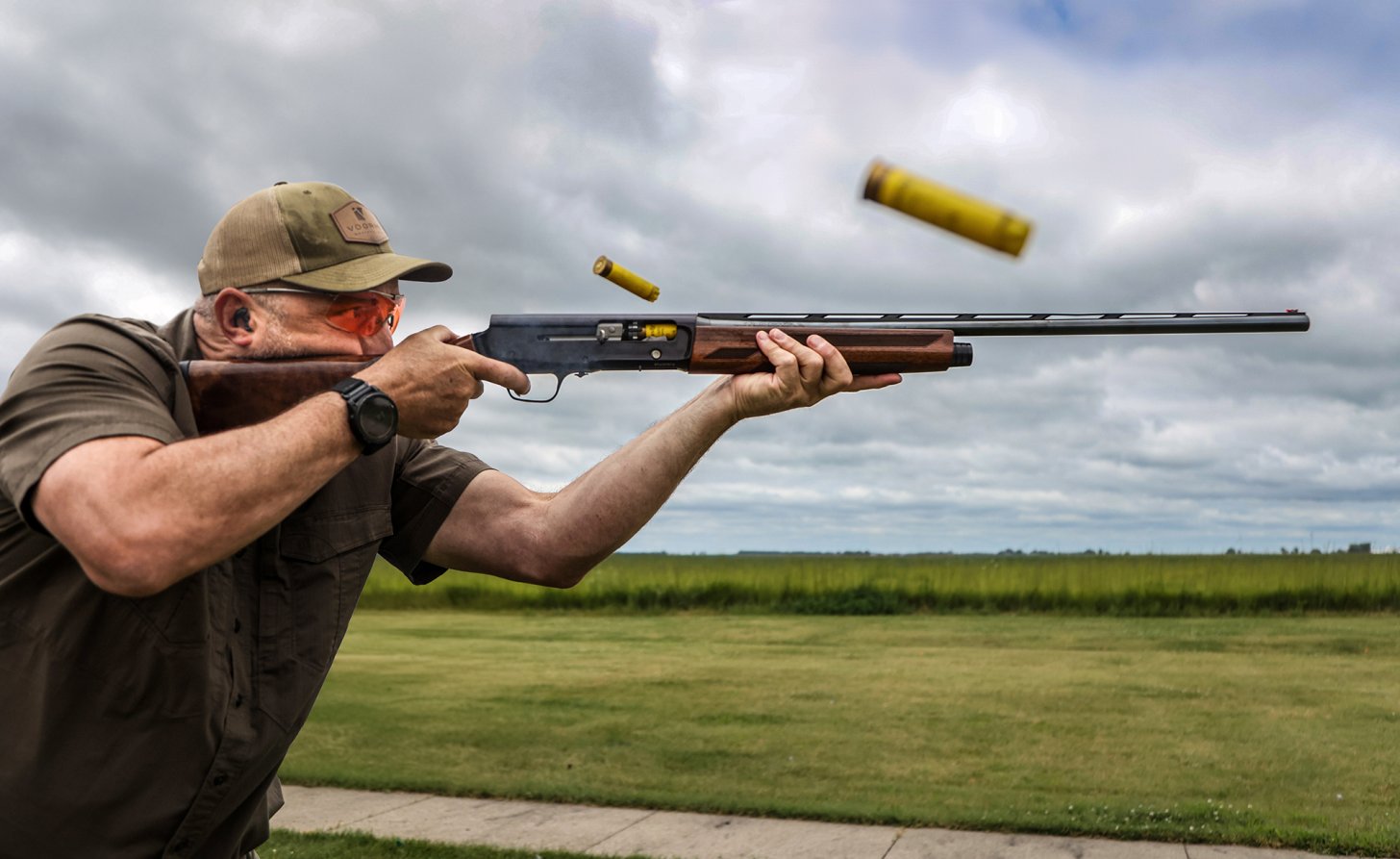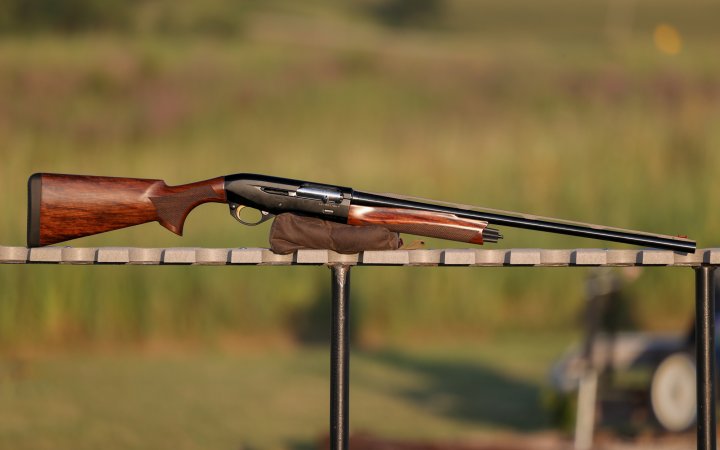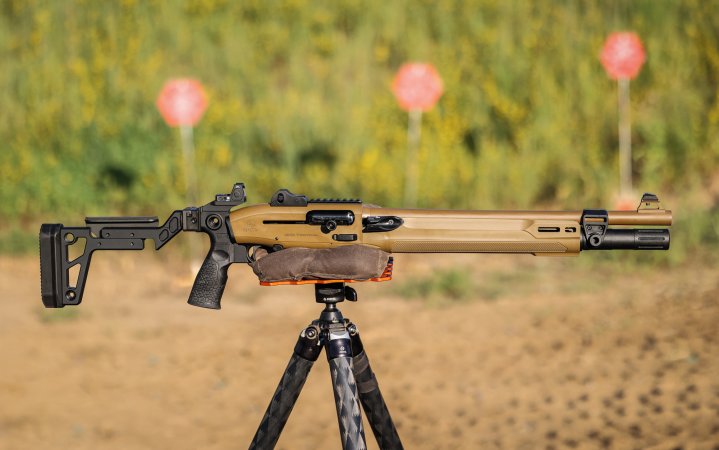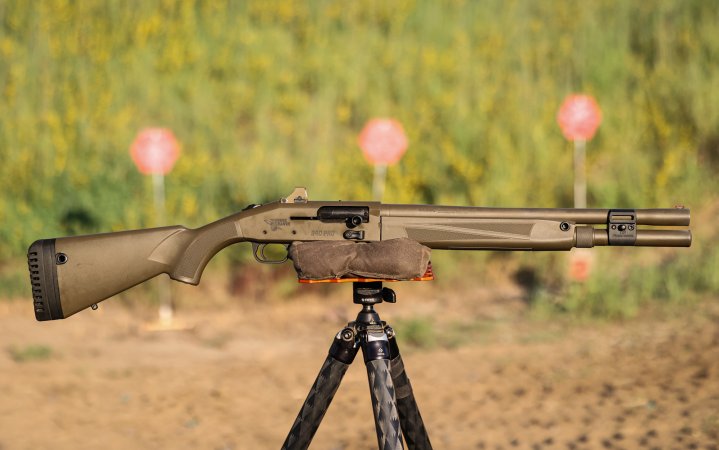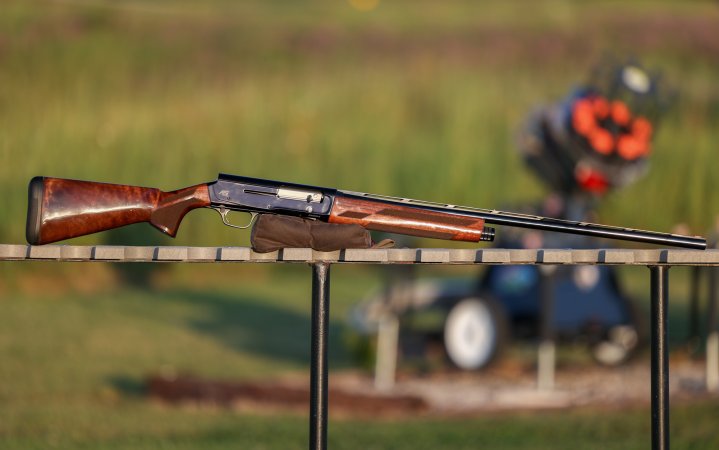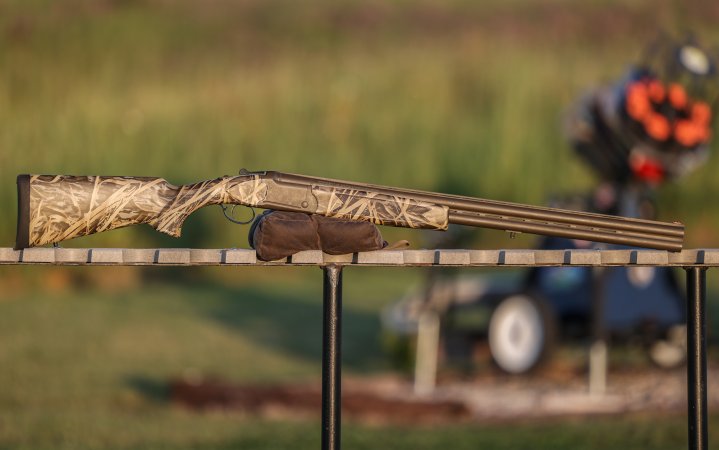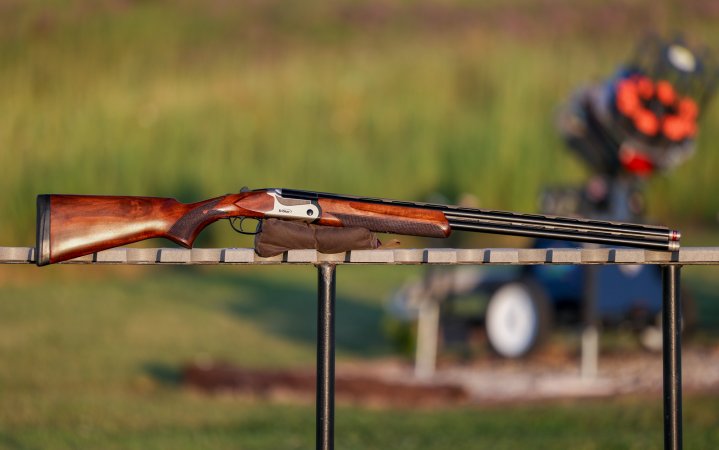We may earn revenue from the products available on this page and participate in affiliate programs. Learn More ›
Evaluating this year’s best shotguns was a challenging task, with introductions covering a gamut of applications. We have everything from fancy ultralight shotguns for upland bird hunters and over-and-under duck guns to general-purpose hunters and racy guns for sporting clays. And scattered among these are guns for budget-conscious shooters, including an intriguing side-by-side for less than $800.
We also tested a full roster of defensive and tactical shotguns, which I’m covering in a separate article (stay tuned). In the meantime, I’ve included a couple of the standouts here.

Photo by Natalie Krebs
But the field isn’t without its flaws. Few guns are perfect — a source of job security for gun writers — and this year that seems to especially be the case. Many of the new shotguns had drawbacks that dimmed our enthusiasm. You will see this reflected in the scores of the hunting shotguns — there are many “good” scores, but no “excellent” ones.
- Editor’s Choice (Hunting): Benelli Montefeltro Ultra Light
- Editor’s Choice (Tactical): Beretta 1301 Tactical Mod 2
- Great Buy (Hunting): Tristar Phoenix
- Great Buy (Tactical): Mossberg 940 JP Thunder Ranch
- Franchi Instinct Sideplate
- Weatherby Sorix
- Browning A5 Hunter, 20 Gauge
- Mossberg Eventide Waterfowl
- Retay Gordion Compact
- Breda 930i
- Tristar Cypher
How We Tested the Best Shotguns

Photo by Matt Foster
As always, we tested the guns by putting them in the hands of a number of capable and unbiased shooters who graded each independently. This year the test team included editor-in-chief Alex Robinson, executive editor Natalie Krebs, freelance writer and competitive three-gunner Matt Foster, and yours truly.
We did our shooting at the Brownells home range outside of Grinnell, Iowa, where we burned up thousands of rounds on the skeet field and Crazy Quail station. We shot the tactical guns (which were all set up with red-dot sights) mostly on a square range, running a variety of drills with target loads, buckshot, and slugs.

Photo by Natalie Krebs
We also banged away at a patterning board to see if the guns point straight, and to figure out the general distribution of their shot.
How We Graded the Best Shotguns
Each shotgun is evaluated on eight categories and given a score of 1 to 5 from each judge. We average these scores for each category and use their total to determine the ranking and awards. The categories are handling, workmanship, aesthetics, ergonomics, meets purpose, versatility, reliability, and value.

Photo by Natalie Krebs
The scores then translate to the grades on the report cards for each firearm. Performance consists of the scores from handling, ergonomics, and reliability. Design includes workmanship, aesthetics, meeting its purpose, and versatility. Value stands on its own.
To earn an “Excellent” rating, the average of that score must be 4.5 or higher, a difficult mark to hit. “Very Good” is an average score of 3.5 to 4.5; “Good” is from 2.5 to 3.5; “Fair” is from 1.5 to 2.5; and “Poor” is under 1.5.
Shotgun Test Ammo

Photo by Matt Foster
We shot a wide variety of shotgun ammo during our testing. Higher end target loads included Federal’s High Overall and Remington’s Premier STS. But we also burned up a bunch of more affordable target loads including Federal Top Gun and Remington Gun Club target loads.

Photo by Natalie Krebs
Buck shot loads included Hornady Critical Defense, Remington Ultimate Defense, and Federal Copper Plated. We shot slugs for record with Remington Slugger, Federal Truball, and Hornady American Gunner.
Best Shotguns: Reviews & Recommendations
Editor’s Choice (Hunting): Benelli Montefeltro Ultra Light
Report Card
- Performance: Very good
- Design: Good
- Value: Good
Benelli Montefeltro Ultra Light Specs
- Gauge: 20
- Action: Semi-auto, inertia
- Capacity: 4+1
- Chamber: 3 inches
- Weight: 5.60 pounds (measured)
- Trigger Weight: 2.31 pounds (measured)
- Barrel Length: 24 inches
- Overall Length: 45.6 inches
- LOP: 14.38 inches
- Sight: Red bar
- Barrel Finish: Gloss Blued
- Stock Finish: Satin Walnut, Grade A
- Price: $1,949
- Includes: Three Crio Chokes (C, IC, M), shim kit
Benelli has developed an effective, if predictable, formula with its shotguns. The company’s introductions from year to year are similar, but we don’t mean that as a dig — far from it. Benelli understands its customers and gives them well-thought-out and refined guns that look, feel, and run great.

Photo by Natalie Krebs
The Montefeltro Ultra Light is a svelte 20-gauge gun that might be the ideal autoloader for hunters who chase grouse and woodcock in alder thickets and wild raspberry brambles where swinging a shotgun requires as much luck as technique.
The reason it is so well suited for that task is its 24-inch barrel, which gives the shotgun an overall length of just 45.6 inches. This unusually short barrel (few shotguns for hunting or sport have barrels less than 26 inches) was our one major point of contention with the Montefeltro Ultra Light, however.
Because it’s so light (5.6 pounds) and compact, the gun has a whippy swing and to a person the test team longed for one with a 26- or 28-inch barrel. Why Benelli only introduced the 20-gauge version with 24-inch barrels is a bit of a head-scratcher since that certainly diminishes its potential appeal to the broader world of bird shooters, but perhaps the gunmaker will remedy that soon.
Otherwise, we had strong, nearly universal, praise for the gun. It loads smoothly, and rapidly, second only to the Browning A5 Hunter in terms of the speed with which you can stuff it with shells. The undercut receiver and scalloped ramp on the trigger guard help guide shells into the magazine, and it is easy to load them two at a time to get back in the action.

Photo by Natalie Krebs
The controls are all positive and easy to manipulate. The bolt release, carrier/action release, and bolt handle are all conveniently positioned and intuitive to operate. The crossbolt safety isn’t our favorite, as it is stiff to operate and doesn’t have any texture machined into it for more positive contact with your finger. But this wasn’t a huge drawback, either.
The stock is attractive and trim, and feels good in the hand. The pistol grip and fore-end have laser-cut checkering that provides good grip and control, and the carbon-fiber rib contributes to the shotgun’s modern looks.
Editor’s Choice (Tactical): Beretta Tactical 1301 Mod 2
Report Card
- Performance: Excellent
- Design: Very Good
- Value: Very Good
Beretta 1301 Tactical Mod 2 Specs
- Gauge: 12
- Action: Semi-auto, gas
- Capacity: 7+1
- Chamber: 3 inches
- Weight: 6.80 pounds (measured)
- Trigger Weight: 2.88 pounds (measured)
- Barrel Length: 18 inches
- Overall Length: 37.8 inches
- LOP: 13 inches
- Sight: Ghost ring, rail included
- Barrel Finish: FDE
- Stock: Folding
- Price: $2,279
- Includes: CL, OCHP flush choke

In the world of defensive and tactical shotguns the Beretta 1301 Tactical Mod 2 stands apart. There are a lot of interesting shotguns in the space that bring much to the party in terms of value, features and performance, but this iteration of the 1301 sets a new highwater mark for the category.

Photo by Natalie Krebs
Thanks to its excellent trigger, ergonomic safety, and superlative gas-operated action, the Beretta 1301 Mod 2 is by far the fastest shotgun we evaluated. The clean trigger break and short trigger reset, along with the speed and reliability of the action, lets the shooter run shells through it at a break-neck clip while retaining control. This is true whether we were firing light target loads or defensive slug and buckshot rounds.
The 1301 comes with an excellent, and durable, adjustable ghost-ring rear sight and fixed front-post that are protected by beefy wings. There’s also a section of Picatinny rail in front of the rear sight for mounting a red dot, as well as a mounting plate on the folding stock that accepts RMR pattern red dots. This gives the operator a lot of options when it comes to selecting a sighting system. That flexibility is complimented by the folding stock from Chisel Machining that adjusts for LOP and cheek height so you match the shooter’s dimensions to the gun’s configuration for a perfect fit.


Photo by Natalie Krebs
The folding stock can also accommodate a shell carrier (which we didn’t have), and even when folded lets the shooter run the gun. It’s a great design.
The fore-end has deep knurling on it for a positive grip and includes three M-Lok slots at the front end for mounting lights or other accessories.
Our sample came with the optional MatchSaverZ, which is a clip that holds an extra shell and screws into the fore-end just ahead of the loading port. When you run the gun dry all you have to do is strip the shell out (with the proper technique) and it will glide into the open port for an extra shot.

Photo by Natalie Krebs
The shotgun loads in a glassy-smooth manner and we could stuff shells into it nearly as fast as we could shoot the gun dry. The lifter doesn’t pinch or bind on your fingers — even if you don’t employ a refined reloading technique. The gun is remarkably forgiving. One ding we found was that we had trouble loading the magazine with a full seven rounds. Sometimes the gun would function with a full seven-round mag, other times it would fail to feed. Ultimately we settled on 6+1 capacity and had no more problems.
The Beretta 1301 shot both slugs and buckshot exceptionally well. It averaged 1.939-inch, 10-shot groups at 25 yards across three different rifled slug loads. With Hornady’s Critical Defense 00 buckshot, all pellets landed within the A Zone of an IPSC target at both 7 yards and 15 yards. At 25 yards, all but two pellets hit within the A Zone and C Zone (those two pellets ended up in the D Zone).

Photo by Natalie Krebs
I’ll have a longer full-length review of this shotgun before long, but suffice to say that it is a gun we can recommend without qualification, and while the $2,500 price tag is steep, it is worth every penny.
Read our full review of the best tactical shotguns here.
Great Buy (Hunting): Tristar Phoenix
Report Card
- Performance: Good
- Design: Good
- Value: Very Good
Tristar Phoenix Specs
- Gauge: 20
- Action: break action, side-by-side
- Capacity: 2
- Chamber: 3 inches
- Weight: 6.84 pounds (measured)
- Trigger Weight: 3.43 pounds (measured)
- Barrel Length: 28 inches
- Overall Length: 45.5 inches
- LOP: 14.25 inches
- Sight: Silver bead
- Barrel Finish: Blued, gloss
- Stock: Turkish walnut
- Price: $795
- Includes: SK, IC, M, IM, F flush chokes
The Tristar Phoenix was one of the bigger surprises of the test. It is a budget-oriented gun, costing only $795, which means it lacks some of the refinements associated with high-dollar doubles (it can be found online for as low as $637). But Tristar made the most with what its gunmakers had to work with, and the Phoenix offers an aspiring aristocrat a compelling package.

Photo by Natalie Krebs
The Turkish-made shotgun has a case-hardened finish on the receiver, high-gloss barrels with flush mounted screw-in chokes, a traditional scalloped sighting rib tipped with a plain brass bead front sight, a tang safety with barrel selectors, gold trigger, and trim fore-end.
The walnut stock isn’t fancy, but is fairly attractive, though the wood on our sample had a slightly gray hue. The checkering is basic too, with an oval pattern on the fore-end that wraps up each side, and two panels on either side of the pistol grip.
In terms of performance, a couple of the shooters on the test shot it as though they were, in Shakespeare’s words, to the manor born. I, on the other hand, have always struggled with side-by-sides, and couldn’t hit the broad side of a pterodactyl with it.

Photo by Natalie Krebs
The only shortcomings of the Phoenix were that the left barrel shot to the left at the patterning board (the center of the pattern was about 5 inches left of point of aim) and the safety, which doubles as the barrel selector, was mushy and imprecise. For the price, however, these are acceptable sins.
Great Buy (Tactical): Mossberg 940 Pro Tactical Thunder Ranch
Report Card
- Performance: Very Good
- Design: Good
- Value: Very Good
Mossberg 940 Pro Tactical Thunder Ranch Specs
- Gauge: 12
- Action: Semi-auto, gas
- Capacity: 7 +1
- Chamber: 3 inches
- Weight: 7.5 pounds (measured)
- Trigger Weight: 2.68 pounds (measured)
- Barrel Length: 18.5 inches
- Overall Length: 37 inches
- LOP: 12.5 to 14.25 inches
- Sight: Red bar, optics ready receiver cut
- Barrel Finish: Cerakote
- Stock: Synthetic, patriot brown
- Price: $1295
- Includes: Fixed cylinder choke
We’ve been big fans of the Mossberg 940 series since it debuted, and have been very happy with their competition, hunting, and defensive models. The 940 Pro Tactical Thunder Ranch is an extension of this winning formula and was one of our favorite shotguns at this year’s test.

Photo by Natalie Krebs
Like other 940s, the Thunder Ranch is easy to load, can be run really fast, is durable and reliable, and represents a great value. As much as we gushed over the Beretta 1301 Mod 2, this shotgun makes a strong case in a head-to-head shootout, especially in light of its budget-friendly price.
The receiver includes an optics cut that we affixed a red dot to, making the shotgun a formidable tool. We had no issue keeping that dot on our target during drills with lots of transitions and while shooting quickly.
The word that kept cropping up during the evaluation to describe the action was “snappy” and we never felt like we were in danger of outrunning the gun. It is super fast.

Photo by Natalie Krebs

Photo by Natalie Krebs
The Thunder Ranch does have a couple limitations that help explain its attainable price. The barrel has a fixed-cylinder bore and only comes with a basic front bead for sighting unless you add a rail or use the optics cut to mount a red dot.
The shotgun ran without any issues, but the charging handle on ours did get a bit wiggly — not to the point where it affected performance but it was a little distracting to our picky, eagle-eyed judges.
From a patterning and accuracy standpoint, the 940 was an overachiever. It recorded our tightest slug group of the test, putting 10 Remington slugger loads within a 1.149-inch group at 25 yards. With Hornady Critical Defense buckshot loads it put all pellets inside the A Zone at 7 yards and 15 yards. At 25 yards it put all pellets inside the A Zone and C Zone.
The safety on the rear of the receiver works great, toggling back and forth in an easy and positive fashion. The safety tab itself has enough relief for your thumb to gain easy purchase, but it isn’t obtrusive or overly bulky.
One interesting refinement is the cocking indicator on the inside of the trigger guard, which is a feature on other 940s as well. This allows you to ascertain the status of the gun in the dark by pressing the back of your trigger finger against the front of the trigger guard to feel for the protruding bit of metal that indicates that the action is cocked.

Photo by Natalie Krebs
The gun has sling mounts for both QD attachments and traditional swivel studs, giving you some flexibility in that regard.
If you want to mount a light on the gun, you can use the M-Lok slots on the barrel clamp for that purpose.
In a competitive field of defensive and tactical shotguns the Mossberg 940 Tactical Thunder Ranch is one of the best values, and was a consensus choice for a Great Buy award.
Franchi Instinct Sideplate
Report Card
- Performance: Good
- Design: Very good
- Value: Good
Franchi Instinct Sideplate Specs
- Gauge: 12
- Action: Break action, over/under
- Capacity: 2
- Chamber: 3 inches
- Weight: 7.47 pounds (measured)
- Trigger Weight: 3.01 pounds (measured)
- Barrel Length: 28 inches
- Overall Length: 46.25 inches
- LOP: 14.25 inches
- Sight: Red bar
- Barrel Finish: Gloss blued
- Stock Finish: AA grade satin walnut
- Price: $2,399
- Includes: Hard case and IC, M, F, extended chokes
The Franchi Instinct Sideplate was introduced last year, but not in time for our 2023 shotgun test. So we included it this year and found it to be an attractive Italian over-and-under that represents a solid value. Its wood is dark and rich, the color case-hardening on the action is well executed, appealing gold-inlay hunting scenes on either side are augmented with engraved scrollwork and borders, and the top lever is sculpted with fine cuts.

Photo by Natalie Krebs

Photo by Matt Foster
It shoots well, too. The Sideplate has an automatic safety that also functions as a barrel selector that operates smoothly with no slop or uncertainty. It comes with extended choke tubes to tune the degree of constriction to the shooter’s preferences, and our sample (chambered in 12 gauge with 3-inch chambers and 28-inch barrels) did a good job breaking clays.
Outdoor Life editor-in-chief Alex Robinson has had the most hands-on experience with the shotgun, as he hunted with it last fall while chasing upland birds and waterfowl in Nebraska. One of the shotgun’s virtues is how comfortable it is to carry in the field.
The shotgun has stood up well to the intense use, showing an appropriate level of wear. That bodes well for its ability to withstand many seasons of hard hunting and age gracefully.

Photo by Natalie Krebs
The only real issue we had with the shotgun was inconsistent ejection. At times it wouldn’t pop empties free from their chamber, which is a bit of a nuisance if not a fatal flaw. Even so, for a shotgun at this price, that cost it points in the reliability category.
The shotgun didn’t fall short in any other respect. The Franchi Instinct Sideplate’s mechanical triggers offer a measure of assurance that you can get a second barrel into play should there be a misfire with the first shot, which is a comfort.
Weatherby Sorix
Report Card
- Performance: Good
- Design: Good
- Value: Good
Weatherby Sorix Specs
- Gauge: 12
- Action: Semi-auto, intertia
- Capacity: 4+1
- Chamber: 3 inches
- Weight: 7.04 pounds (measured)
- Trigger Weight: 3.54 pounds (measured)
- Barrel Length: 28 inches
- Overall Length: 49 inches
- LOP: 14.3 inches
- Sight: Red bar
- Barrel Finish: Cerakote
- Stock Finish: Synthetic, hand painted
- Price: $1,500
- Includes: C, IC, M, IM, F (flush chokes)
This is a solid, well-balanced bird gun meant to withstand the rigors of waterfowl hunting, but it’s light and handy enough to work well on pheasant and other upland game. Weatherby is importing the Sorix from Italy, and it is an inertia-driven gun that runs in a manner similar to Benelli semi-autos.
The Sorix has a synthetic stock adorned with a camo pattern that’s applied by hand at Weatherby’s Sheridan, Wyoming, facility and the brush-stroke pattern gives it a distinct look and adds some texture to the gun for a more positive grip.

Photo by Natalie Krebs

Photo by Natalie Krebs
One of the shotgun’s selling points is the ability to switch the bolt handle from one side of the action to the other, which makes it more appealing and ergonomic for left-handed shooters. The left side of the receiver has a slot that’s been cut along its length so the bolt handle can travel back and forth as the action cycles.
We had mixed reactions to this feature. Given a duck gun’s natural habitat — muddy marshes with water, ice, cattails, and reeds — any opening that potentially allows debris to enter the action is to be viewed with suspicion.
Even for the left-handed shooter in our group (Matt Foster), the benefit of moving the bolt handle to the other side was dubious. According to Foster, moving just the Sorix’s charging handle, when its bolt release tab and loading part remain on the right of the receiver, doesn’t fully solve a southpaw’s problems while shooting a right-handed shotgun. Added to this, the bolt handle on our sample model didn’t fit tightly when inserted on the left side of the gun, and it didn’t take much effort to pull free, which was another point of concern — potentially losing the bolt handle in the field would be a major pain. The right-handed duck hunters on the test team were suspicious of the slot cut into the left side of the receiver as it serves as just another place for mud and debris to work into the action.

Photo by Natalie Krebs
We also encountered feeding issues with the shotgun. Every couple of boxes of shells, the Sorix would fail to feed, with the shell getting hung up in the receiver. This happened with both target and duck loads, so it didn’t seem to depend on the potency of the shell. Keeping the action well lubricated didn’t remedy the issue either, so we never discovered the cause of this gremlin.
Still, the shape of the receiver and design of the shell lifter allowed us to reload the Sorix quickly. After removing the plug, the magazine could hold four 2 ¾-inch shells, so it was a blast to run on the Crazy Quail. I was able to get off five rounds during each Crazy Quail sequence, reload five, and shoot them (or as many as were needed for the remaining targets) within a 20-second sequence with two other shooters on the line. That bodes well for its capabilities when the birds are coming in thick and fast over the dekes.
Browning A5 Hunter 20 Gauge
Report Card
- Performance: Good
- Design: Good
- Value: Good
Browning A5 Hunter Specs
- Gauge: 20
- Action: Semi-auto, inertia
- Capacity: 4 +1
- Chamber: 3 inches
- Weight: 5.52 pounds (measured)
- Trigger weight: 2.53 pounds (measured)
- Barrel Length: 26 inches
- Overall Length: 47.25 inches
- LOP: 14.25 inches
- Sight: Ivory mid bead, red bar
- Barrel Finish: Gloss blued
- Stock Finish: Turkish Walnut, Grade I
- Price: $1,980
- Includes: Invector DS chokes (C, IC, M), and hard case
This modern version of the A5 has been out for many years in both 12 and 16 gauge, but this is the first year that it’s being offered in a 20-gauge. We had mixed feelings about this shotgun. While some of us loved how the A5 Hunter handled, praising both its speed of operation and ability to smash distant targets, others found it didn’t particularly suit them. We also had mixed reactions concerning its looks and workmanship. Much of the gun seems well thought out and elegant, while other elements could have been executed with more care, especially in light of the A5 Hunter’s price.

Photo by Natalie Krebs
Without question, it is the fastest shotgun we tested in terms of reloads and getting it into play. The speed-load feature, which automatically loads a shell when the bolt is locked back and you insert a cartridge into the magazine tube, is legit. It allows you to get an extra round downrange quickly, or load the gun to capacity in a flash by loading a single round followed by stuffing the magazine two shells at a time (a technique common in multi-gun competition).
While shooting Crazy Quail, I was able to push the gun (and my shooting abilities) to the limit, getting five rounds on target and then reloading again with three more shells before all the targets were thrown. No other shotgun in the test could equal its rate of fire.

I also found the A5 Hunter’s 26-inch barrel gave it a “just right” swing for my large frame and the shotgun seemed to zero in of its own accord on long targets.

Photo by Natalie Krebs

Photo by Natalie Krebs
Not everyone on the team was quite as enthusiastic as me about the gun’s fit and handling. Two of the judges found the gun a bit awkward to wield, which goes to show that you should always try before you buy when possible.
Ergonomically the A5 Hunter holds its own. The trigger is decent, though has a bit of creep. The cross-bolt safety is generously sized with good cross-hatching, and toggles back and forth in a positive manner that isn’t too stiff or mushy. The bolt handle and bolt-release tab have traditional proportions — neither are oversized, as has become common on semi-autos — but operate effectively.

Photo by Natalie Krebs
Aesthetically, the A5 has some pluses and minuses. The high gloss wood and metal is attractive, but we weren’t crazy about the checkering. The checkering is effective, but the placement of the panels on the fore-end is a bit odd looking.
The gun is easy to take down and service, and the inertia-driven system with its rotating bolt head was 100 percent reliable and didn’t give us any feeding problems during the evaluation.
Mossberg Eventide Waterfowl
Report Card
- Performance: Very good
- Design: Good
- Value: Good
Mossberg Eventide Waterfowl Specs
- Gauge: 12
- Action: Break-action, over/under
- Capacity: 2
- Chamber: 3.5 inches
- Weight: 7.35 pounds (measured)
- Trigger weight: 5.88 pounds (measured)
- Barrel Length: 28 inches
- Overall Length: 45.5 inches
- LOP: 14.25 inches
- Sight: Red bar
- Barrel Finish: Cerakote (patriot brown)
- Stock Finish: Synthetic (Mossy Oak Vintage Shadowgrass)
- Price: $956
- Includes: C, IC, M, IM, F, chokes
There are probably two types of hunters who will be drawn to the Eventide Waterfowl, a camo-coated over-and-under from Mossberg.
One is the double-gun enthusiast, who looks down their nose at shotguns with only one barrel, and the other is the technical bad-weather waterfowler who wants the reliability of a simple shotgun when the hunting conditions are at their worst.

Photo by Natalie Krebs
In keeping with the Eventide’s bare-bones design, it lacks ejectors, so the shooter needs to withdraw the shells manually from the barrel. This has an obvious impact on the speed with which the Eventide can be employed, and could be an issue when flights are hot and heavy.
But it serves its basic mission well. It is a tough O/U that does a good job breaking clays, and surprised us by how well it managed the recoil of magnum duck loads. (We shot these in through the Eventide and the Weatherby Sorix, the other waterfowl gun in the test, in a back-to-back shootout. Both duck guns handled the recoil in a nearly equivalent manner.)
We did have one glitch with the gun that affected its reliability score. When opening the gun, it is possible to unlock the lugs without pushing the top lever over fully. When this happens the top lever will not click into its open locked position, meaning the locking bars in the receiver will prevent the action from closing.

Photo by Natalie Krebs
When running the Eventide Waterfowl quickly (or as quick as it can be run) we had this issue several times. It is easy enough to correct by making sure you push the top lever all the over to the end of its range of motion, but it was a persistent issue. The other thing we noted was that at the patterning board the bottom barrel impacted noticeably to the left. The fit and finish on this gun were rough, but that’s typical of a sub-$1,000 duck gun.
Retay Gordion Compact
Report Card
- Performance: Good
- Design: Good
- Value: Good
Retay Gordion Compact Specs
- Gauge: 20
- Action: Semi-auto, inertia
- Capacity: 4+1
- Chamber: 3 inches
- Weight: 6.01 pounds (measured)
- Trigger weight: 2.56 pounds (measured)
- Barrel Length: 24 inches
- Overall Length: 44.5 inches
- LOP: 12.5 to 13.5 inches
- Sight: Red bar
- Barrel Finish: Wrapped (Mossy Oak Bottomland)
- Stock Finish: Synthetic
- Price: $850
- Includes: C, IC, M, IM, F (Marapro chokes)
We were impressed by the Retay Gordion we tested in 2023, a Turkish-made Benelli knock-off that earned a Great Buy award. That full-sized gun, a 20-gauge, ran extremely well and though we could see where Retay saved money versus the Benelli, we felt they cut all the right corners.

Photo by Natalie Krebs
This year they’ve come out with a compact version of that same gun, and again we came away impressed. With its cut-down dimensions it is an ideal youth or petite ladies gun that would work great on waterfowl, upland birds, or turkeys (the turkey specific Gordion model shoots exceptional patterns). One key feature that makes this an appealing youth gun is that you can adjust the length of pull by removing up to four plastic inserts between the stock and the recoil pad. As your young hunter grows, you can add inserts back as needed, maximizing the amount of field time the Gordion Compact will get before it becomes a hand-me-down.

Photo by Natalie Krebs
At around $850 it is a good value for what it represents and is sure to make any young hunter beam with pride as they carry it to the duck blind or into the turkey woods.
Breda 930i
Report Card
- Performance: Very Good
- Design: Good
- Value: Good
Breda 930i Specs
- Gauge: 12
- Action: Semi-auto, inertia
- Capacity: 3+1
- Chamber: 3 inches
- Weight: 7.76 pounds (measured)
- Trigger weight: 3.31 pounds (measured)
- Barrel Length: 28 inches
- Overall Length: 49.25 inches
- LOP: 14.5 inches
- Sight: Red bar
- Barrel Finish: Gloss blued
- Stock Finish: Walnut
- Price: $2,300
- Includes: Hard case and C, IC, M extended chokes
We haven’t spent a lot of time with Bredas until now, but we came away impressed by this Italian semi-auto, which has a significant following with European shooters. It is an inertia-driven gun with a chromed, rotating bolt head that is similar to Benelli’s design. If we were to find a Benelli analog for the 930i, it would be the Ethos Super Sport, which costs about $2,350.

Photo by Natalie Krebs
This competition-oriented shotgun has some attractive features, including a cheek piece that adjusts for height and offset, and a selection of weights that can be added to the cap on the fore-end to tune the gun’s balance. After tuning the 930i, we found it swung on targets with authority and was certainly one of the more capable clay-smashers in the test, working well for all the judges who have a variety of body sizes and shooting styles.
The shotgun was quick to get on targets and handled recoil well, and the included weights, which can be added to the cap on the fore-end, made a notable difference in the 930i’s swing.

Photo by Natalie Krebs

Photo by Natalie Krebs

Photo by Natalie Krebs
Aesthetically, the Breda makes a good impression, too. The walnut stock has some nice figure to it, the stainless finish on the receiver is offset with anodized electric blue components, including the trigger guard, oversized bolt handle, oversized bolt release tab, and the fore-end cap.
The laser cut stippling on the fore-end and pistol grip is in keeping with the gun’s sporty vibe and is effective.
On close inspection, the Breda isn’t as refined as the Ethos Super Sport. It doesn’t have the same level of fit and finish and attention to detail, and we did notice some premature wear on the gun that makes us wonder about its long-term durability. The loading process is a bit sticky, and our fingers tended to get caught in the shell lifter as we stuffed rounds into the magazine. Also, the safety isn’t very ergonomic.
Tristar Cypher
Report Card
- Performance: Good
- Design: Fair
- Value: Good
Tristar Cypher Specs
- Gauge: 20
- Action: Over/Under, ejectors
- Capacity: 2
- Chamber: 3 inches
- Weight: 6.58 pounds
- Trigger Weight: 2.61 pounds
- Barrel Length: 28 inches
- Overall Length: 45.25 inches
- LOP: 14.25 inches
- Sight: Red bar
- Barrel Finish: Blued, gloss
- Stock Finish: Turkish Walnut
- Price: $960
- Includes: Three Crio Chokes (C, IC, M), shim kit

Photo by Natalie Krebs
Tristar has a bit of a “Matrix” vibe going with a couple of its shotguns. While Tristar makes a Trinity model, we tested the Cypher. Of course, Cypher is a villain in the iconic movie, so that might strike some Gen X nerds who are in the market for a budget priced over-and-under as a curious move.
That’s not the only thing about this gun that struck us as odd. The aesthetics of the shotgun blend modern elements — see the laser-engraved micro text on the receiver that reads “cypher” — and traditional flourishes, like the teardrop, or drop point, on the stock that, frankly, don’t work together.

Photo by Natalie Krebs

The shotgun handled targets well enough, which was a redeeming feature. The gun is made in Turkey and has mechanical triggers, but the barrel selector, which is incorporated into the safety, was mushy and imprecise, and during our evaluation sometimes ended up stuck in a position where the gun wouldn’t shoot.
Final Thoughts on the Best Shotguns of 2024

Photo by Natalie Krebs
This field of new shotguns was a bit of a mixed bag, to be honest. We have some clear winners, such as the two defensive shotguns that won awards: the Beretta 1301 Mod 2 and Mossberg 940 Tactical Thunder Ranch. Both these we recommend without hesitation.
With respect to the hunting shotguns we tested, the field was a little murkier. We loved the Benelli Montefeltro Ultra Light, but its 24-inch barrel is somewhat limiting, so you might consider the regular Montefeltro if you’re looking for a more versatile bird gun in this price range.
The Tristar Phoenix is a heck of a value in a side-by-side, but you should try before you buy to make sure that style of shotgun suits you. The Browning A5 is another intriguing option to explore for those looking for a light, semi-auto sub-gage.
As a sporting clays gun, the Breda 930i warrants a look and gives a lot for the money, but we’d suggest comparing it to the Benelli Ethos Super Sport to see which feature set and configuration is more appealing to you at that price.
- Editor’s Choice (Hunting): Benelli Montefeltro Ultra Light
- Editor’s Choice (Tactical): Beretta 1301 Mod 2
- Great Buy (Hunting): Tristar Phoenix
- Great Buy (Tactical): Mossberg 940 JP Thunder Ranch
- Franchi Instinct Sideplate
- Weatherby Sorix
- Browning A5 Hunter, 20 Gauge
- Mossberg Eventide Waterfowl
- Retay Gordion Compact
- Breda 930i
- Tristar Cypher
